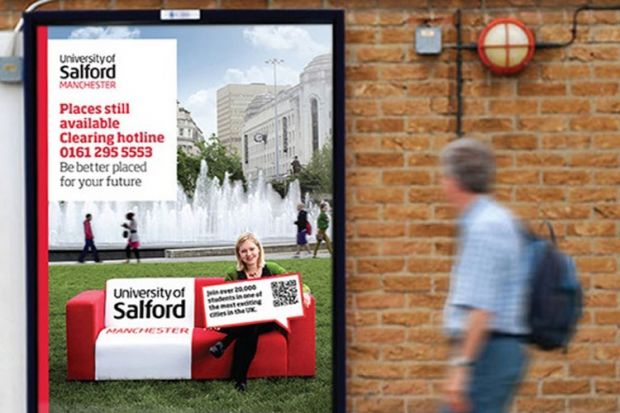A university trebled its spending on advertising aimed at prospective students over the past three years even as it prepared to shut an array of courses hit by low student demand.
Figures obtained under the Freedom of Information Act show that the University of Salford increased its spending on adverts aimed at new students by more than half a million pounds between the 2010-11 and the 2012-13 academic years, from £226,114 to £775,946.
That increase came against the backdrop of a turbulent period for student demand. According to Ucas figures, applications to the university fell by 14 per cent from 2011 to 2012.
Low student demand led to the institution taking the decision last year to close nearly all its modern language, politics and contemporary history courses, with a view to eventually shutting the entire School of Humanities, Languages and Social Sciences.
At the time the university’s vice-chancellor Martin Hall said the cuts were necessary “to secure the future of the university”.
This is not the first time the troubled institution has come under scrutiny for its spending.
Salford attracted criticism for paying £30 million to build its new campus at MediaCityUK, and it hit the headlines in 2012 for spending £132,000 on a rebrand that altered its logo to include the word “Manchester”.
Martyn Moss, the University and College Union’s regional official for the North West, said that while universities now had to employ a range of tactics to attract students, it was wrong for Salford to treble its spending on student marketing.
“Increasing expenditure on marketing is an obvious way to [try to attract students], but it is wrong that institutions feel such pressure that they are prepared to treble the amount of money spent on an area that is peripheral to their core business of education,” he said.
“At the UCU, we believe that money would be far better spent on improving the quality of students’ education. University staff are currently taking industrial action over a five-year pay freeze, yet they see money being ploughed into other areas like this.”
In a statement, a Salford spokesman said: “The closure of a small number of courses was justified on the basis that they were losing the university money due to the lack of student demand.
“At the same time the university has to compete fiercely with other universities to attract students to the courses that are popular. The university’s marketing spend enabled us to compete effectively for students in what had become a much more competitive marketplace.”
The University of Salford contacted Times Higher Education on 16 January 2014 to say that it had supplied incorrect figures in its Freedom of Information response. It has supplied the following statement and updated figures on non-staff advertising and marketing:
“The marketing expenditure figures supplied by the University of Salford for the period 2010 to 2013 were incorrect. We apologise for this error. The statistical accounts show that in 2010-2011 total marketing spend was £1,661,858 made up of £605,054 advertising, £310,139 exhibition expenditure and £688,976 other marketing expenditure. In 2011-12 the total marketing spend decreased to £1,350,997 and in 2012-13 total marketing spend fell to £1,320,944.
Advertising and exhibition expenditure combined in 2010-11 stood at £906,139. In 2011-12 this figure decreased to £807,148 and in 2012-13 stood at £1,064,599.
Advertising expenditure alone stood at £605,054 in 2010-11. This decreased in 2011-12 to £559,145 and increased to £797,385 in 2012-13.”





